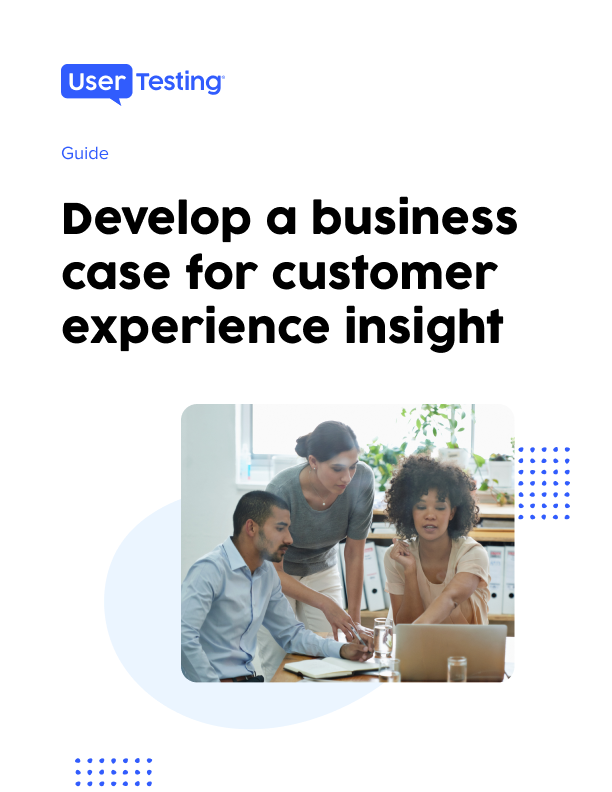How to overcome 3 common objections to conducting remote customer research

Recently, Stephanie Fishel-Brown, a Principal UX Researcher for UserTesting, delivered a talk to students enrolled in Georgia Tech’s Master's of Science in Human-Computer Interaction. Below is a summary of one of the topics Stephanie covered in her presentation.
Depending on how mature your company’s CX practice is, getting folks to warm up to the idea of remote, unmoderated customer research can sometimes be a bit challenging. As with any type of research, many factors need to be considered before a viable strategy can be implemented. One factor is choosing the type of research that you’ll conduct, as that will have a direct impact on timing, budgets, resources, and objectives. At UserTesting, there are a few objections that usually pop up when remote, unmoderated testing is suggested. In today’s article, I’ll cover three of the most common objections we hear, along with some suggestions on how to handle them.
What if test participants become distracted?
Test participant distraction can be both a blessing and a curse when it comes to customer research. A ringing phone, a crying baby, a barking dog, just about anything that we encounter in everyday life has the potential to disrupt someone participating in a test. That distraction, however, shouldn’t always be viewed as a negative. The reality is that these distractions, as in life, are often unavoidable. Observing how a test participant reacts to distractions during their test may highlight areas where improvements or enhancements can be made to help meet customer needs, despite everyday distractions.
How to handle it
Gone unchecked, however, distractions have the potential to take a tester off course and away from the task at hand. Since some distraction is natural, it’s important to consider that when writing your test plan. Giving participants clear instructions at every stage of the test is crucial. It’s also helpful to incorporate reminders in tasks to help keep participants on track. For example, if you want participants to simply visit a website and look around, but not to select any links, be sure to call that out in the task instructions: Visit www.usertesting.com and look around the page. **Do not select any links or visit any other pages within the site just yet.** After spending about 2 minutes on this page, continue to the next task. If a participant is too distracted to provide any usable feedback, you can always launch the test with a new participant.
What about privacy?
This one comes up a lot and with good reason. Companies depend on their intellectual property being protected, and test participants need to be assured that their privacy will be protected as well.
How to handle it
Fortunately, handing this objection is pretty straightforward. Companies concerned with protecting their intellectual property can simply have test participants sign a non-disclosure agreement before participating in the study. To protect test participants, personally identifiable information can automatically be blurred in the test videos, or you can provide participants with mock information they can use, such as a made-up email address, name, or phone number.
What if I want to observe the test participant’s body language?
If you’re already looking into gathering qualitative insights, then it’s natural to ask about the ability to observe body language, too. How a test participant responds to tasks and questions is an important and valuable layer that can provide a richer understanding of the entire experience.
How to handle it
Although you won’t be observing test participants in real time, it is possible to get a sense for their body language and reactions. In fact, at UserTesting we’ve found that you can pick up on the same cues from a person’s intonation and inflection as you could through visual observation. Additionally, it’s always a good idea to layer in opportunities for test participants to voice any concerns that may not have been observable while listening to the video. For example, you can have a participant complete a task, then ask a series of follow up questions about their experience. This helps you get both the objective observation and the subjective reactions.
The benefits of unmoderated research
The benefits of conducting unmoderated research are compelling:
- Less expensive than moderated research
- Faster
- Reduces moderator bias
- Natural testing environment for test participants (versus a lab)
- No scheduling required
- Not constrained by geographic location
- No need for dedicated testing facilities
No matter what type of research your team agrees on, the most important thing is to keep your customer at the center of everything that you do. Gathering continuous human insights is a great way to make sure that your products and services are meeting customer needs.
Want to learn more?
To learn how UserTesting can help you understand your customers through on-demand human insights, contact us here.
Get the guide
Improving your organization’s customer experience (CX) doesn’t happen overnight. It requires a combination of influencing key decision-makers and proving results. This guide will equip you with a plan to gain buy-in and momentum for your CX improvements.
For over a decade, Stephanie Fishel-Brown has helped organizations capture high-quality, action-oriented insights to improve their customer experience. At UserTesting, she leads a team of researchers whose mission is to deliver impactful human insights that inform business decisions. When she’s not obsessing over research, she’s spending time with family and friends.







